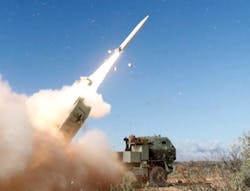Lockheed Martin to build 57 missiles with radio homing and infrared guidance to hit targets 300 miles away
REDSTONE ARSENAL, Ala. – Tactical missile designers at Lockheed Martin Corp. are building some of the first U.S. Army long-range Precision Strike Missiles (PrSM) to destroy enemy targets as far away as 300 miles.
Officials of the Army Contracting Command at Redstone Arsenal, Ala., announced a $77.4 million order last month to the Lockheed Martin Missiles and Fire Control segment in Grand Prairie, Texas, for 54 PrSM missiles.
The PrSM, which should enter service in 2023, will be a surface-to-surface, all weather, precision-strike guided missile fired from the M270A1 Multiple Launch Rocket System (MLRS) and the M142 High Mobility Artillery Rocket System (HIMARS).
Last December Lockheed Martin won a $23.9 million order for PrSM full-scale development and early operational capability. The long-range precision-attack PrSM is to replace non-insensitive and cluster munition versions of the Army MGM-140 Army Tactical Missile System (ATACMS).
PrSM will provide Army and Marine Corps field artillery units with long range and deep strike capability. The PrSM will destroy, neutralize, or suppress targets at ranges from 43 to 250 miles using indirect precision fires.
Lockheed Martin and the Army are developing multi-mode terminal guidance for PrSM that combines RF signal sensors and electro-optical infrared sensors.
The missile uses Global Positioning System (GPS) satellite navigation and inertial gyro navigation to reach the vicinity of its targets. Once the missile reaches its target area, it listens for radio signals from enemy radar or communications to refine its targeting, and finally uses an imaging infrared sensor to pinpoint its target before impact.
Its radio homing and imaging infrared guidance also will help the missile eventually reach moving targets on land and at sea.
The baseline missiles will be able to engage a wide variety of targets at ranges as long as 310 miles. It will emphasize imprecisely located area and point targets. Primary emphasis for follow-on upgrades will be on increased range, lethality, and ability to attack time-sensitive, moving, hardened, and fleeting targets.
By 2025 the Army will be able to use PrSM to attack and destroy moving enemy ships operating offshore at ranges out to about 310 miles. While the weapon primarily has surface-to-surface applications for use against enemy air defenses, troop fortifications, and armored vehicle columns, the PrSM is being configured with an advanced targeting multi-mode seeker to include maritime strike.
The new targeting seeker has completed a captive carry test wherein it flew aboard an aircraft against representative targets in preparation for further testing and ultimate deployment.
On this order Lockheed Martin will do the work in Grand Prairie, Texas, and should be finished by September 2025. For more information contact Lockheed Martin Missiles and fire control online at www.lockheedmartin.com, or the Army Contracting Command-Redstone at https://acc.army.mil/contractingcenters/acc-rsa/.
About the Author
John Keller
Editor-in-Chief
John Keller is the Editor-in-Chief, Military & Aerospace Electronics Magazine--provides extensive coverage and analysis of enabling electronics and optoelectronic technologies in military, space and commercial aviation applications. John has been a member of the Military & Aerospace Electronics staff since 1989 and chief editor since 1995.
